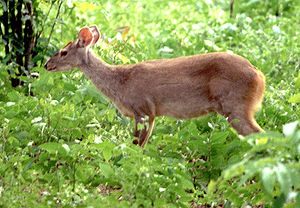Pike deer
| Pike deer | ||||||||||||
|---|---|---|---|---|---|---|---|---|---|---|---|---|

Graumazama ( Mazama gouazoubira ) |
||||||||||||
| Systematics | ||||||||||||
|
||||||||||||
| Scientific name | ||||||||||||
| Mazama | ||||||||||||
| Rafinesque , 1817 |
The spit deer or Mazamas ( Mazama ) are a genus of mammals from the deer family (Cervidae). They are forest-dwelling animals that live in Central and South America. The exact number of species is controversial, the IUCN recognizes ten separate species, the reference work Mammal Species of the World there are nine.
The name Mazama , which is not only the scientific generic name, but is also used, for example, for the German trivial name , is the Nahuatl word for "deer", so it originally comes from Mexico.
features
The antlers are completely unbranched and consist of only two short skewers. As a result, these deer are reminiscent of duiker antelopes , to which they are, however, not closely related. The size varies considerably between the species. With a height of 40 centimeters and a weight of 10 kilograms, the dwarf mazama is not much larger than a rabbit; on the other hand, the two largest species, the red and gray azama, are 70 centimeters tall and weigh 25 kilograms, the size of a deer. The fur is monochrome and varies, depending on the species, between light gray and reddish brown.
habitat
Common deer are little known and rarely seen. This is due to the fact that they have such hidden habitats, are camouflaged in the undergrowth with their fur colors and remain motionless when they encounter a person.
Way of life
Little is known about the way of life. They appear to live as solitary animals who only come together during the mating season. Leaves, grasses and fruits are their food.
The species
Today ten types are distinguished:
- Great Mazama or Red Mazama ( Mazama americana ( Erxleben , 1777))
- Coastal forest mazama ( Mazama bororo Duarte , 1996)
- Northern dwarf mazama ( Mazama bricenii Thomas , 1908)
- Southern dwarf mazama ( Mazama chunyi Hershkovitz , 1959)
- Graumazama ( Mazama gouazoubira ( Fischer , 1814))
- Little Mazama ( Mazama nana ( Hensel , 1872))
- Amazonian Mazama ( Mazama nemorivaga ( F. Cuvier , 1817))
- Yucatán-Mazama ( Mazama pandora Merriam , 1901)
- Red small mazama ( Mazama rufina ( Pucheran , 1851))
- Mexico Grand Mazama ( Mazama temama ( Kerr , 1792))
The Great Mazama, the Graumazama and the Amazonian Mazama are widespread across the lowland forests of South America. The other smaller species, however, live in the forests on the mountain slopes of the Andes or in the eastern coastal regions. The southern dwarf mazama sometimes rises to heights of up to 4000 m. The Mexico and Yucatán Mazama inhabit the rainforests of Central America , the former has been proven up to an altitude of 2800 m. Both were originally considered subspecies of the great mazama, but now have their own species status. According to genetic studies, the Northern dwarf mazama may only be a subspecies of the red small mazama.
literature
- Don E. Wilson, DeeAnn M. Reeder (Eds.): Mammal Species of the World . 3rd edition. The Johns Hopkins University Press, Baltimore 2005, ISBN 0-8018-8221-4 .
- Ronald M. Nowak: Walker's Mammals of the World . The Johns Hopkins University Press, Baltimore 1999, ISBN 0-8018-5789-9 .
Individual evidence
- ^ A b S. Mattioli: Family Cervidae (Deer). In: Don E. Wilson and Russell A. Mittermeier (eds.): Handbook of the Mammals of the World. Volume 2: Hooved Mammals. Lynx Edicions, Barcelona 2011, ISBN 978-84-96553-77-4 , pp. 440-443
- ↑ Eliécer E. Gutiérrez, Jesús E. Maldonado, Aleksandar Radosavljevic, Jesús Molinari, Bruce D. Patterson, Juan M. Martínez-C., Amy R. Rutter, Melissa TR Hawkins, Franger J. Garcia and Kristofer M. Helgen: The Taxonomic Status of Mazama bricenii and the Significance of the Táchira Depression for Mammalian Endemism in the Cordillera de Mérida, Venezuela. PLoS ONE 10 (6), 2015, p. E0129113. doi: 10.1371 / journal.pone.0129113
- ↑ Nicola S. Heckeberg, Dirk Erpenbeck, Gert Wörheide and Gertrud E. Rössner: Systematic relationships of five newly sequenced cervid species. PeerJ 4, 2016, p. E2307 doi: 10.7717 / peerj.2307
Web links
- Endangerment level of the individual species in the IUCN Red List of Threatened Species .
